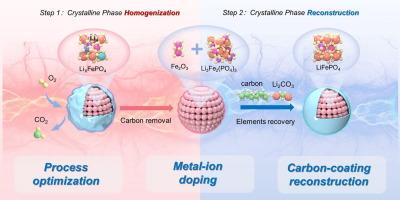LiFePO4均相再生的可控相重构策略:反应机理、表征及展望
IF 14.9
1区 化学
Q1 Energy
引用次数: 0
摘要
报废锂离子电池(lib)数量的不断增长既是一个紧迫的环境挑战,也是一个关键的资源机遇,尤其是对正极材料而言。在商用阴极中,LiFePO4 (LFP)因其良好的性能而占据市场主导地位;因此,相当数量的LFP正极材料预计将在不久的将来退役。传统的湿法冶金方法成本高,污染严重。直接再生技术,特别是固态烧结,通过高温固相反应修复阴极结构,而无需额外的化学试剂,提供了更高效、更环保的替代方案。传统的固态烧结在处理各种来源的废LFP时面临着挑战,难以实现物理化学性质和电化学性能的均匀化。为了解决上述限制,研究人员研究了采用晶格重建策略的相均质化,该策略可以实现有效的晶格重建和微观结构均质化,并对来自不同来源的废样品显示出强大的适应性。本文系统地综述了LFP可持续回收的机理、具体步骤、表征技术、预氧化优化(包括离子掺杂和包覆碳层改性)的研究进展,以及未来的研究方向。因此,本文将为实现LFP阴极的均匀再生提供理论指导。本文章由计算机程序翻译,如有差异,请以英文原文为准。

Controllable phase-reconstruction strategy for LiFePO4 homogeneous regeneration: reaction mechanism, characterization and prospect
The growing volume of end-of-life lithium-ion batteries (LIBs) represents both an urgent environmental challenge and a critical resource opportunity, especially for cathode materials. Among commercial cathodes, LiFePO4 (LFP) dominates the market due to its favorable properties; thus, a substantial amount of LFP cathode materials is expected to retire in the near future. The conventional hydrometallurgical method suffers from high costs and serious pollution. Direct regeneration technologies, especially solid-state sintering, provide a more efficient and environmentally benign alternative by repairing cathode structures through high-temperature solid-phase reactions without extra chemical reagents. Traditional solid-state sintering faces challenges in processing spent LFP from diverse sources, struggling to achieve the homogenization of physical–chemical properties and electrochemical performance. To address the limitations above, phase homogenization with a lattice reconstruction strategy has been investigated, which can enable effective lattice reconstruction and microstructural homogenization, demonstrating robust adaptability to spent samples from variable sources. This review systematically summarizes the mechanisms, detailed steps, characterization techniques, and advances in pre-oxidation optimization (including ion-doping and coated carbon layer modification), as well as future research directions for sustainable LFP recycling. Given this, this review is expected to offer theoretical guidance for achieving homogeneous regeneration of LFP cathode.
求助全文
通过发布文献求助,成功后即可免费获取论文全文。
去求助
来源期刊

Journal of Energy Chemistry
CHEMISTRY, APPLIED-CHEMISTRY, PHYSICAL
CiteScore
19.10
自引率
8.40%
发文量
3631
审稿时长
15 days
期刊介绍:
The Journal of Energy Chemistry, the official publication of Science Press and the Dalian Institute of Chemical Physics, Chinese Academy of Sciences, serves as a platform for reporting creative research and innovative applications in energy chemistry. It mainly reports on creative researches and innovative applications of chemical conversions of fossil energy, carbon dioxide, electrochemical energy and hydrogen energy, as well as the conversions of biomass and solar energy related with chemical issues to promote academic exchanges in the field of energy chemistry and to accelerate the exploration, research and development of energy science and technologies.
This journal focuses on original research papers covering various topics within energy chemistry worldwide, including:
Optimized utilization of fossil energy
Hydrogen energy
Conversion and storage of electrochemical energy
Capture, storage, and chemical conversion of carbon dioxide
Materials and nanotechnologies for energy conversion and storage
Chemistry in biomass conversion
Chemistry in the utilization of solar energy
 求助内容:
求助内容: 应助结果提醒方式:
应助结果提醒方式:


